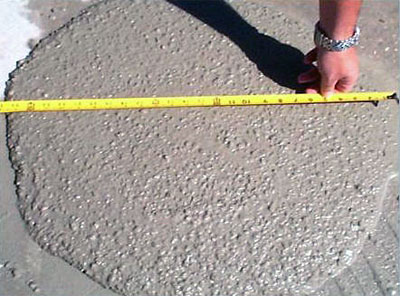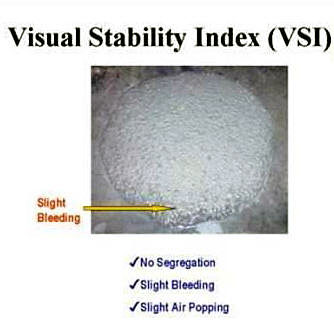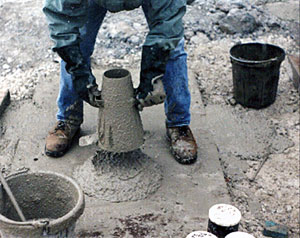Testing
 Several test procedures have been successfully employed to measure the plastic properties of Self-Consolidating Concrete. The slump flow test, using the traditional slump cone, is the most common field test and is in the process of being standardized by ASTM. The slump cone is completely filled without consolidation, the cone lifted, and the spread of the concrete measured. The spread can range from 18 to 32 inches (455 to 810 mm). The resistance to segregation is observed through a visual stability index (VSI). The VSI is established based on whether bleed water is observed at the leading edge of the spreading concrete, or if aggregates pile at the center. VSI values range from 0 for “highly stable” to 3 for unacceptable stability.
Several test procedures have been successfully employed to measure the plastic properties of Self-Consolidating Concrete. The slump flow test, using the traditional slump cone, is the most common field test and is in the process of being standardized by ASTM. The slump cone is completely filled without consolidation, the cone lifted, and the spread of the concrete measured. The spread can range from 18 to 32 inches (455 to 810 mm). The resistance to segregation is observed through a visual stability index (VSI). The VSI is established based on whether bleed water is observed at the leading edge of the spreading concrete, or if aggregates pile at the center. VSI values range from 0 for “highly stable” to 3 for unacceptable stability.
 During the slump flow test, the viscosity of the SCC mixture can be estimated by measuring the time taken for the concrete to reach a spread diameter of 20 inches (500 mm) from the moment the slump cone is lifted up. This is called the T20 (T50) measurement and typically varies between 2 and 10 seconds for SCC. A higher T20 (T50) value indicates a more viscous mix which is more appropriate for concrete in applications with congested reinforcement or in deep sections. A lower T20 (T50) value may be appropriate for concrete that has to travel long horizontal distances without much obstruction.
During the slump flow test, the viscosity of the SCC mixture can be estimated by measuring the time taken for the concrete to reach a spread diameter of 20 inches (500 mm) from the moment the slump cone is lifted up. This is called the T20 (T50) measurement and typically varies between 2 and 10 seconds for SCC. A higher T20 (T50) value indicates a more viscous mix which is more appropriate for concrete in applications with congested reinforcement or in deep sections. A lower T20 (T50) value may be appropriate for concrete that has to travel long horizontal distances without much obstruction.
The U-Box and L-Box tests are used for product development or prequalification and involve filling concrete on one side of the box and then opening a gate to allow the concrete to flow through the opening containing rebar. The J-ring test is a variation to the slump flow, where a simulated rebar cage is placed around the slump cone and the ability of the SCC mix to spread past the cage without segregation is evaluated.

The U- box, L-box and J-ring tests measure the passing ability of concrete in congested reinforcement. Another test being standardized is a column test, which measures the coarse aggregate content of concrete at different heights in a placed columnar specimen as an indication of stability or resistance to segregation.
|
||||||||||||


